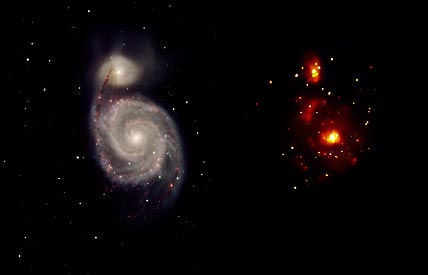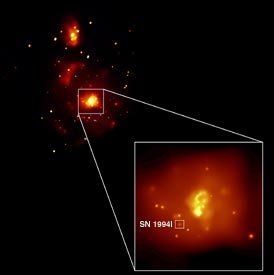
The Whirlpool Galaxy, M51, seen in visible light (left) and as seen by the Chandra X-ray observatory (right) at the same scale and orientation.
Chandra image courtesy NASA/CXC/University of Maryland./A.Wilson. NOAO image courtesy NOAO/AURA/NSF/T.A.Rector and Monica Ramirez.
Few celestial objects capture the essence of astronomy. These are the fundamental images — views that invoke both wonder and familiarity. Surely on that list is the Whirlpool Galaxy (M51). It practically defines spiral galaxies, and it has been seen by nearly every telescope ever built, from backyard scopes to the Hubble Space Telescope.
Now Andrew Wilson (University of Maryland) and his colleagues using the Chandra X-ray Observatory have, quite literally, looked at this classic in an entirely different light. Imaging the galaxy in X-rays, Chandra revealed a galactic core brimming with high-energy objects including black holes, neutron stars in binary systems, and multimillion degree gas. Also visible was a rare supernova nestled behind a dusty veil.

The Whirlpool Galaxy is just recognizable in this Chandra X-ray Observatory image. Notice the Supernova near the galaxy's core.
Courtesy NASA/CXC/University of Maryland/A.Wilson
The supernova in question is SN1994I, now eight years old. It was a rare breed of stellar explosion known as Type Ic. Unlike most supernovae, before their violent explosions type Ic objects shed their outer layers of hydrogen much the same way a planetary nebula does. In this case, the supernova is surrounded by a star-debris cloud 0.2 light-year in diameter. Monitoring the cloud will reveal just how much mass the star gave up before it blew up.
 0
0
Comments
You must be logged in to post a comment.